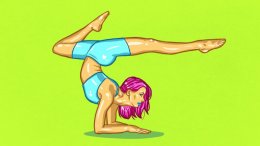
Advanced Yoga Poses
 Take one look at someone in Scorpion Pose and you’ll know: yoga can build strength and balance. But …
Take one look at someone in Scorpion Pose and you’ll know: yoga can build strength and balance. But …
Advanced poses demand strength, flexibility, muscular endurance, and balance. Working up to a challenging pose is a fitness goal in its own right, just as valid as wanting to run a mile in a certain time, or wanting to bench press a certain number of pounds. If you use yoga as cross-training for another sport, those challenging poses can become a side goal that keeps you interested instead of getting bored with yet another series of down dogs.
I’m not going to say you should learn advanced poses to impress people at your yoga class, because (deep yoga breath) every body is different. Comparing yourself to others is not helpful for anyone. But if you can do difficult poses, you will certainly impress yourself (and maybe friends at parties). I can testify that the three seconds I was able to hold Crow pose on a paddleboard ranks as one of my top athletic accomplishments.
Start by Choosing an Appropriate Goal
Whatever your current level, some poses will be attainable for you and some will be way out of your league. If you’re new to yoga, get started by doing beginner level routines (preferably at an in-person class) until you get a sense of what is easy and what is difficult for you.
Yoga offers a host of health benefits, including stress relief and mental clarity, but many people…
Set your sights on a pose that’s out of reach, but where you can see a progression from your current fitness level. This may include modified versions of the pose, supplemental exercises to help you develop the strength and skills you’ll need, and variations that use props (like blocks or straps) to help you along the way. There are some helpful videos at the end of this post, or research your chosen poses on websites like Yoga Journal’s Challenge Pose series. Don’t forget that your friendly neighborhood yoga instructor is another great resource.
Get Instruction and Practice at Home
Most yoga practitioners fall into one of two camps: those with a YouTube-centered practice who wouldn’t dare venture out of the privacy of their living room, and those who do yoga by taking classes, but can’t be bothered to find the time or place to practice anywhere else.
While either approach can work when you’re using yoga as an occasional strength or flexibility routine, combining both is your best bet when you want to get serious about progressing toward a goal.
A good teacher can critique your form and help you figure out what exactly you need to stretch, strengthen, or focus on to improve. And unless you have a class that coincidentally works on the exact skills you’re trying to perfect, you’ll want to spend time in what yogis call your “daily practice” working on whatever you need to work on.
When you look at your yoga instructor (or that super talented person in the front row), you may…
Document Your Progress
Don’t be surprised if something you thought you could almost do turns out to be farther away than you thought. When you start really learning the important components of a pose, your progress may feel backwards at first. Maybe you could hold a certain pose for 30 seconds, but your instructor clues you in to some key mistakes you’re making. Now that you’ve fixed your form, the pose is much harder—maybe you can only hold it for five seconds.
But if you’re doing the pose better, and that’s progress. Consider having a friend take pictures of you (or propping up your phone to take videos from across the room) so you can see your form improve over time. And if you’re the type to keep a training journal, keep your yoga progress in there too. This way you can celebrate milestones, say the first time you were able to do a headstand without falling over, and you can look back at the progress you’ve made over time.
Some Specific Pathways to Advanced Poses
Exactly how you work up to an advanced pose depends on the pose and on your body—what specifically is holding you back from reaching it?
A typical progression involves a multi-pronged approach:
- Working on strength, flexibility, and balance over time, through other poses and exercises
- Doing modified versions of the pose that are less challenging, but help you build the strength you need to work up to the more advance version
- Using objects to help support your body or otherwise change the physics of the pose. These might be blocks to raise up or stabilize you, straps to help you hold a foot you can’t quite reach yet, or even pillows under sensitive body parts (like your face) in case you would fall.
- Mental preparation, in some cases: it’s possible to psych yourself out if a pose seems scary—like if you’re afraid of falling.
Here are a few advanced poses with tutorials in how to work up to them.
Low Plank (Chataranga Dandasana)
Low plank comes up in every sun salutation, but a lot of us skip it by just dropping to the floor a few seconds early. When you do it right, you’re essentially holding the bottom position of a push-up for what feels like forever and pretending it’s no big deal.









